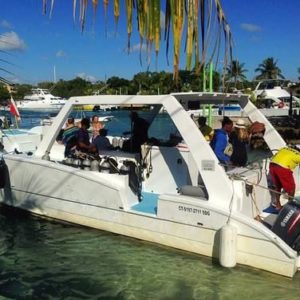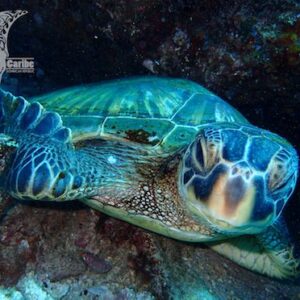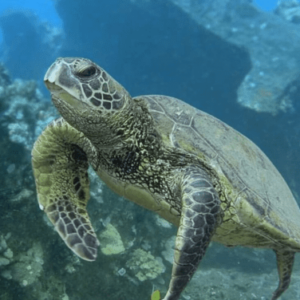
The Dominican Republic may be best known for its plethora of all-inclusive resorts but this vibrant Caribbean nation has so much more to offer visitors. Located on the island of Hispaniola, travelers will love the laid-back vibes, vibrant nightlife and hundreds of beautiful beaches. History buffs will enjoy strolling the cobblestone streets of Santo Domingo (one of the oldest cities in the Caribbean) while thrill-seekers can get their adrenaline rush whitewater rafting, paragliding, horseback riding and waterfall hunting. And thanks to its large coastline, scuba diving and snorkeling in the Dominican Republic is excellent for all levels.
GETTING THERE
-
The Dominican Republic is a Caribbean country, meaning U.S. citizens require a passport to travel there. See TSA requirements for the most up to date information.
-
The Dominican Republic is well connected with plenty of flight options from the United States, Canada and Europe. The main airports are Las Américas International Airport in Santo Domingo (SDQ)and Punta Cana International Airport (PUJ), with additional international airports in Puerto Plata, Santiago and Samaná.
-
The best way to get around the Dominican Republic is by car—either a rental from the airport or one of the unmetered multi-passenger taxis found along the main drags called públicos. Spot a público by the white seal on the front door.
GOOD TO KNOW
-
The Dominican Republic is a Caribbean country.
-
Time zone: Coordinated Universal Time and Greenwich Mean Time.
-
Primary languages: Spanish and English.
-
Currency: Dominican peso. U.S. dollars and Euros are accepted in many tourist areas.
-
Phone and internet: Phone service is available from most U.S. phone carriers (you may need to activate international roaming). Internet is readily available including Wi-Fi at hotels and restaurants. The international calling code is +809.
-
Voltage: 110 (The U.S. voltage is 120 V so Americans can use their electric appliances in the Dominican Republic).
-
Hurricane season runs from June to October in the Dominican Republic.
-
There are currently no travel health and safety notices in effect for the Dominican Republic.
DIVE CONDITIONS
-
Water temperatures range from 75 degrees Fahrenheit in winter to 84 degrees in summer. The Caribbean side of the island is typically warmer than the Atlantic side.
-
Average water visibility is 50 to 100 feet but can be higher or lower depending on the weather.
-
WHEN TO GO
-
The Dominican Republic offers great diving conditions all year round.
-
The best time for whale watching is late December to April.
-
The peak season for tourism is December to May.
-
-
WHAT YOU’LL SEE
- Between the reefs, wall dives, caves and shipwrecks, divers can expect to encounter a variety of colorful marine life in the Dominican Republic including turtles, nurse sharks, butterflyfish, eagle rays, barracuda and jacks. A major highlight is diving to the soundtrack of humpback whales that visit the Silver Banks in February and March.

BEST SCUBA DIVING SITES IN THE DOMINICAN REPUBLIC
CATALINA ISLAND
This small island and national park located about 5 miles off the southern coast of the Dominican Republic is home to two fantastic dive sites that are best for more advanced divers. The Wall drops to 100 feet and houses mesmerizing black corals, sponges and tropical fish. The Aquarium is shallower at only 40 feet deep and true to its name, is a hot spot for puffer fish, barracudas, stingrays and more.
BOCA CHICA
With its calm waters and relatively shallow depths, this protected bay located just outside of the island’s capital is great for beginners. Here you’ll find an array of hard and soft coral and sponges with colorful reef fish, spiky crustaceans, magical starfish and lively seahorses. And because of Santo Domingo’s history as one of the most bustling ports in the New World, expect to encounter more than a few historical wrecks resting on the sand bottom.
BAYAHIBE
Off the shore of this charming fishing village you’ll find tranquil and crystal-clear waters that offer divers of all levels diverse marine life encounters including turtles, eels, tropical fish and maybe even a passing manatee. The Atlantic Princess shipwreck lies 45 feet below the surface and is great for both beginners (who can check out the front deck) and more experienced divers (who can explore the cavernous compartments).
LUPERON WALL, NORTH COAST
Advanced divers will love gliding next to eels, grouper, barracuda, turtles, manta rays and more at this rich wall that’s located 15 minutes from the shore by boat.
BEST SNORKELING IN THE DOMINICAN REPUBLIC
While the Atlantic side of the Dominican Republic can be rough, snorkelers can happily float around the calm waters of the Caribbean on the island’s southern coast. Popular offshore snorkeling sites include Cayo Arena, Sosua and La Romana. And don’t miss Catalina island or the Silver Banks during whale season.
DISCOVER UNIQUE THINGS TO DO IN THE DOMINICAN REPUBLIC
SANTO DOMINGO
Explore one of the oldest cities in the Caribbean, complete with cobblestone streets, UNESCO-protected landmarks and ancient churches. But although the city (particularly the central neighborhood of Zona Colonial) may be steeped in history, the galleries, cafés and bustling restaurants are totally hip.
PUNTA CANA
This postcard-worthy destination located on the eastern tip of the Dominican Republic offers gorgeous white sandy beaches, swaying palm trees and turquoise waters. This is the ultimate relaxation destination for sun-worshippers who are perfectly happy going from their all-inclusive resort to the pool and then on to the beach—on repeat.
SALTO ALTO
Ready your Instagram for this jaw-droppingly beautiful waterfall on Península de Samaná. After snapping the obligatory photos, take a dip in the lagoon and soak up the rainforest atmosphere.






















